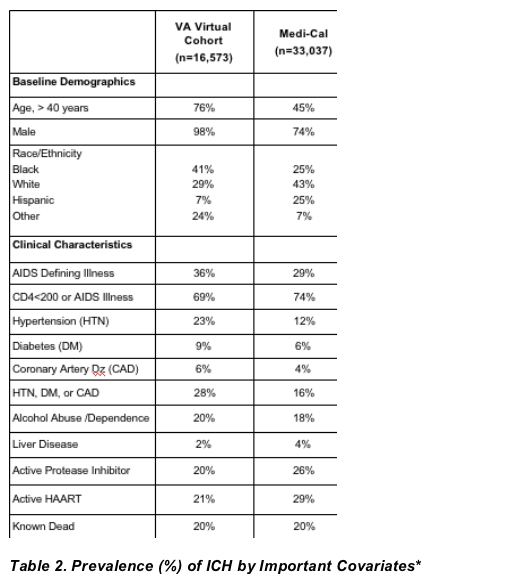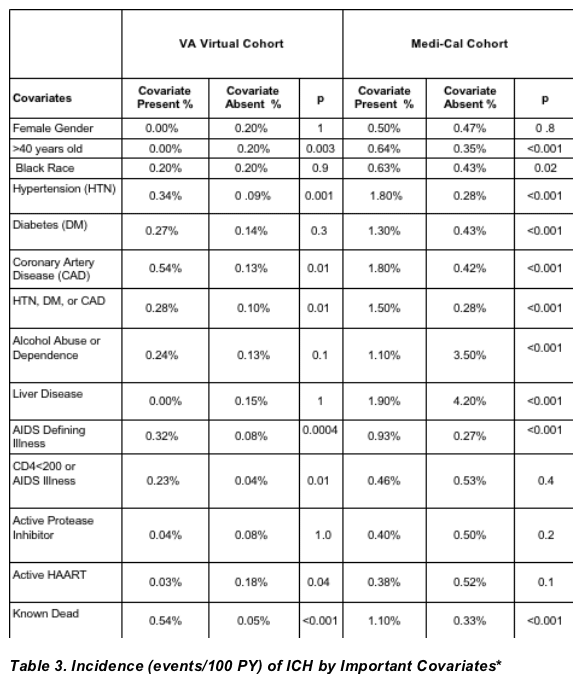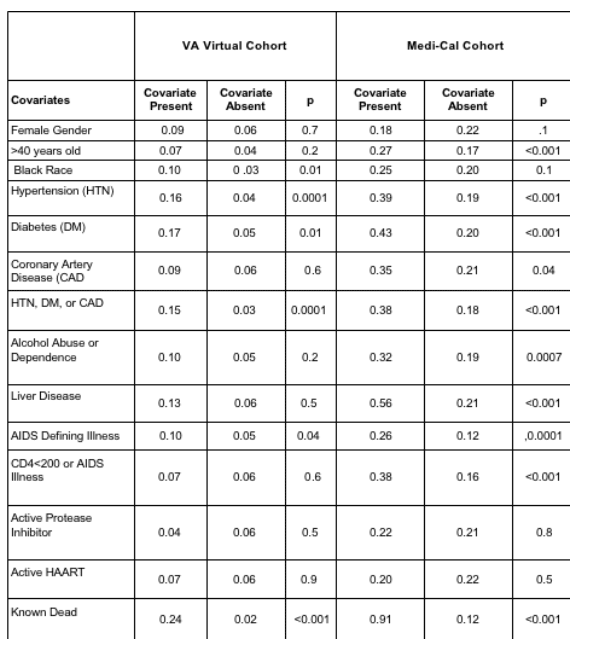 |
 |
 |
| |
Evaluation of Intracranial Hemorrhage in 49,610 HIV-Infected Veterans and California Medicaid Recipients
|
| |
| |
Reported by Jules Levin
CROI, Feb 2007, Los Angeles
Shawn L. Fultz 1, David Zingmond 2, Kirsha S. Gordon 3, Joseph L. Goulet 3, Larry Mole 4, Joseph T King, Jr 3,4, Dawn Bravata 3,4, Hernan Valdez 5,
Michael Kraft 6, Amy C Justice 3,4, and VACS Project Team
Office of Public Health and Environmental Hazards, Veterans Health Administration, Department of Veterans Affairs1~University of California Los Angeles, Los Angeles, CA, USA2~VA Connecticut Healthcare System, West Haven, CT, USA3~Yale University School of Medicine, New Haven, CT, USA4~VA Palo Alto Health Care System, Palo Alto, CA, USA5~Boehringer Ingelheim Pharmaceuticals, Inc., Ridgefield, CT, USA6~Boehringer Ingelheim Pharmaceuticals, Inc., Ingelheim, Germany7
OBJECTIVES
To examine the rate of intracranial hemorrhage in an HIV-infected population not exposed to TPV during the HAART.
BACKGROUND
HIV has become a complex chronic disease with extended life expectancy and concomitant long term exposure to antiretroviral (ARV) therapy.
Common long-term drug toxicities with ARV therapy appear as comorbid conditions.
In pre-approval trials, 13 of 6840 patients (0.20%) exposed to tipranavir (TPV) have developed intracranial hemorrhage (ICH) at an incident rate of 0.26 per 100 person years of exposure (95% CI 0.09, 0.61). It is unknown whether this rate exceeds that observed with other, non TPV containing HAART regimens.
METHODS
We identified HIV-infected individuals under care in the U.S. between October 1997 and December 2003 through the US Veterans Healthcare System-derived Virtual Cohort 1 and the California state Medicaid (Medi-Cal) program 2.
In the Virtual Cohort, patients were identified as being HIV infected by virtue of having at least two outpatient or one inpatient codes for HIV. This algorithm was validated against the VA Immunology Case Registry Data which requires each VA site to confirm the HIV status of patients included in the registry.
HIV infected Medi-Cal enrollees were identified by the Medical Care Statistical Section of Medi-Cal using case identification from claims and eligibility data developed for ongoing review of HIV-related costs and utilization. AIDS was determined by either two outpatient or one inpatient claims for AIDS or confirmation in the California AIDS Registry.
ICH was identified using ICD-9 codes (430.xx, 431.xx and 432.xx, except 432.0)3. Subjects who had ICD-9 codes indicating trauma or ischemic stroke complicated with intracranial hemorrhage were excluded. Other diagnoses were identified using standard, validated, ICD-9 code groupings.
Prevalence was defined as ICH events occurring from 12 months before to 6 months after date of initial presentation for HIV care.
Incidence (per 100 person-years) was defined as events occurring after this time frame.
Poisson regression was used to model incidence rates after adjusting for covariates.
FINDINGS
Sample included 16,573 veterans and 33,037 California Medicaid recipients for a total of 49,610 individuals with HIV infection
Veterans were older (>40 years of age); more likely to be male (98% vs. 74%), and less likely to have developed AIDS (36% vs. 74%) compared to Medi-Cal recipients (Table 1, p<0.001).
Within 12 months before baseline and 6 months after baseline, there were 25 ICH prevalent cases 0.2% (95% CI 0.1-0.2%) within the VA and 173 ICH prevalent cases 0.5% (95% CI 0.4-0.6%) within Medi-Cal.
The VA Virtual Cohort observed 27 incident cases 0.07 (95% CI: 0.05-0.10) per 100 PY and Medi-Cal observed 274 incident cases 0.23 (0.5 CI: 0.20-0.25) per 100 PY.
Overall and in every stratified analyses, the prevalence and incidence of ICH was lower among veterans than among those receiving Medi-Cal coverage (Table 2 and 3, p<0.001).
Stratified analyses showed similar associations in both cohorts.
Prevalence and incidence of ICH were higher among those
-- Over 40 years of age
-- With hypertension, diabetes, or coronary artery disease
-- With alcohol abuse
-- With an AIDS defining illness
-- Prevalence and incidence of ICH did not differ by active receipt of protease inhibitors or HAART.
CONCLUSIONS
VA incidence rates of ICH were lower than those observed in pre marketing trials of Tipranavir, but Medi-Cal rates were similar (Figure 1).
ICH events may be less completely captured:
In observational databases using ICD-9 codes than in prospective clinical trials
in the VA because patients with acute life threatening conditions may go to the nearest hospital rather than a VA facility for emergency care.
While many risk factors for ICH established outside HIV infection appear to apply, we do not see increased rates of ICH among women compared to men.
We also see no evidence of increased rates among those on protease inhibitors or on HAART compared to those not on these treatments.




*Prevalent intracranial hemorrhage events are identified using ICD-9 codes and were deemed prevalent if they occurred within 12 months prior or 6 months after baseline. Events occurring after this point were considered incident. Active medications are defined as any drug for which the patient has a prescription that would not have run out on or by the baseline date. Neither database captures nonprescription nonsteroidal anti-inflammatory agents such as aspirin. Hypertension, diabetes, coronary heart disease, alcohol abuse and dependence, and liver disease are determined based upon the presence of ICD-9 diagnostic.
REFERENCES
1. Fultz SL, Skanderson M, Mole LA et al. Development and verification of a 'virtual' cohort using the National VA Health Information System. Medical Care 2006; 44(8 Suppl 2): S25-S30.
2. Zingmond, DS,Ettner SL, Cunningham WE. The impact of managed care on access to highly active antiretroviral therapy and on outcomes among HIV-infected Medicaid beneficiaries. Medical Care Research and Review. In press.
Rosamond WD, Folsom AR, Chambless LE et al. Stroke incidence and survival among middle-aged adults: 9-year follow-up of the Atherosclerosis Risk in Communities (ARIC) cohort. Stroke 1999; 30(4): 736-743
|
| |
|
 |
 |
|
|